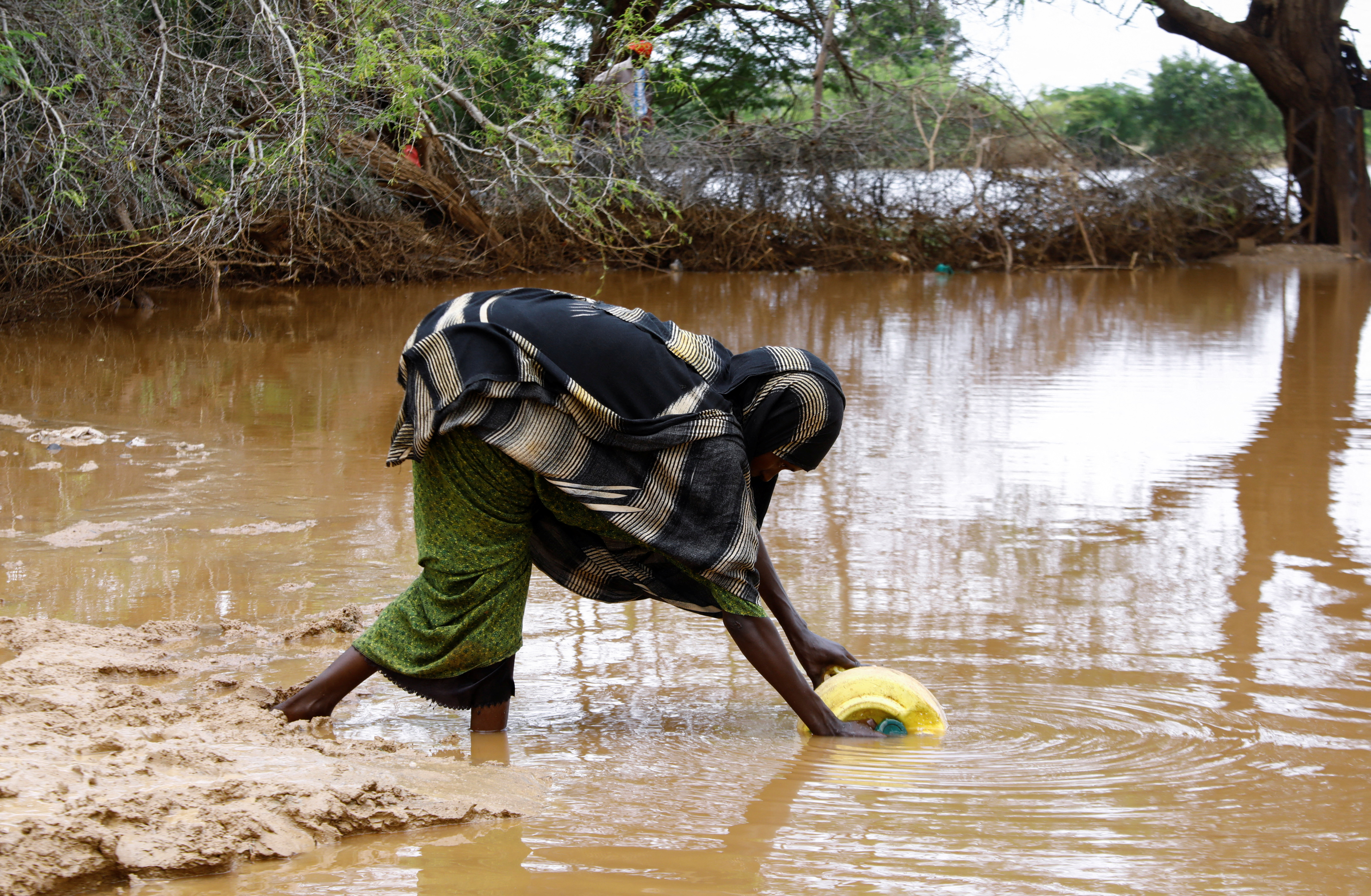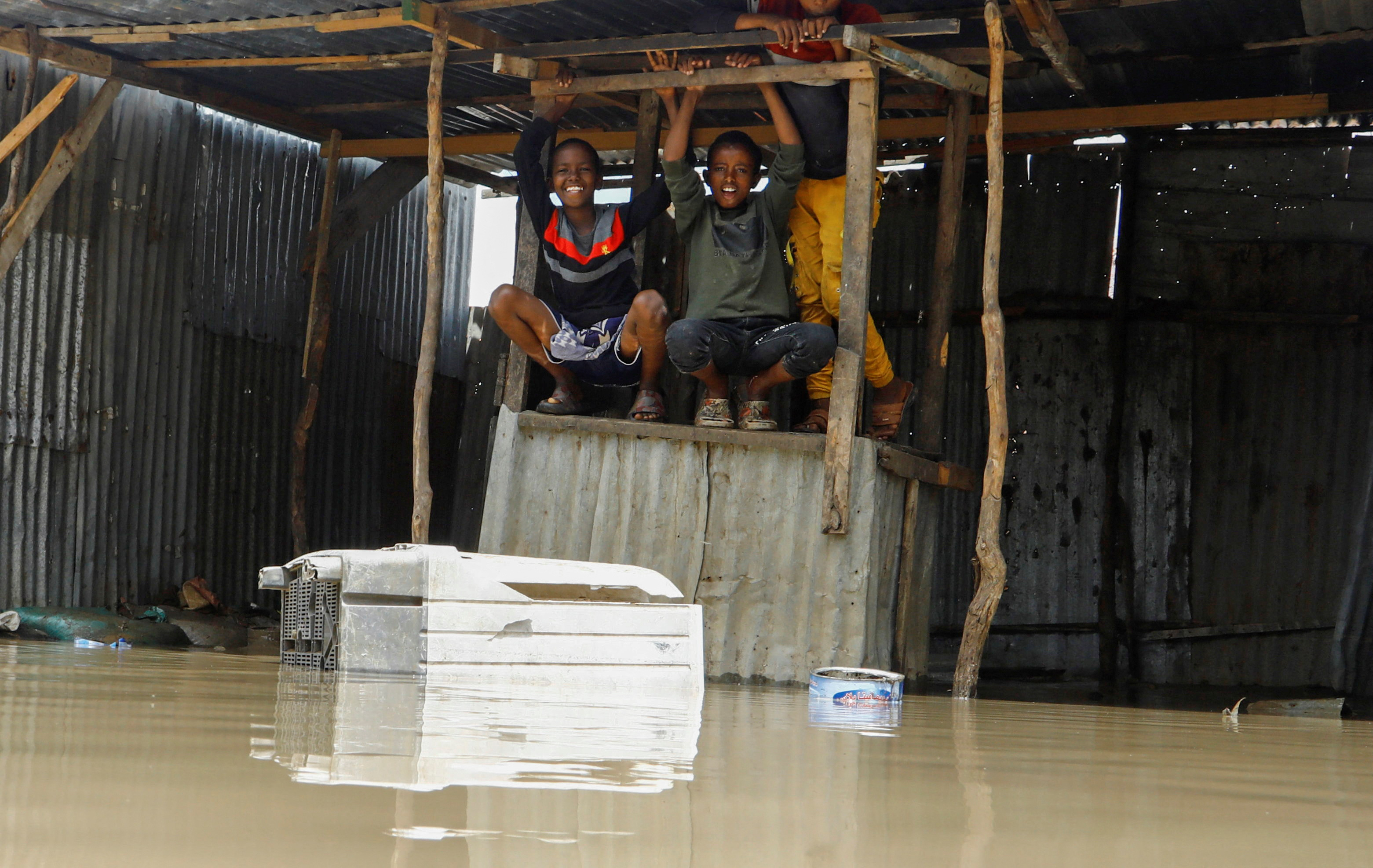
At a camp for internally displaced people on the outskirts of Baidoa city in southwest Somalia, Halima Abdi, 57, walks through the flooded compound to access her makeshift house. It is partly submerged in the water, which had forced her to leave the previous day.
Most of her neighbours have left to seek shelter in Baidoa and, as she stands in the almost-empty camp of scattered shanty houses, she checks to see what is left after the flood swept away her belongings.
“We were forced to flee after three days of heavy rain that almost took our lives,” Abdi, a single mother of seven children told Al Jazeera. “We are left with nothing but just the pillars of the house, and the floods swept away all our goods including the utensils, mattress and clothes. I have rescued my children and taken them to a different house in the town.”
Early last year, Abdi sought refuge at the camp to get aid after a severe drought destroyed their maize farm in Manaas village, about 45km (28 miles) south of Baidoa and could barely get anything to feed her children. It was the worst drought the Horn of Africa had experienced in four decades. Since then, she has been dependent on aid in the form of food and medicine to survive.
Today, her fortunes have been dampened again.
“We couldn’t plant anything due to the failed rainfall in four consecutive seasons and that is why we come to the camp looking for a better life. Now it has rained heavily and my makeshift house isn’t there any more and I literally have to swim back when accessing the main road,” she added.
Climate change has upended lives and livelihoods across the region in the last two years. The United Nations has said 4.3 million people, a quarter of Somalia’s population, are at risk of “crisis-level hunger or worse” this year due to drought and floods.
Kevin Mackey, Somalia country director of the NGO World Vision, has said children are among the most affected groups and are now “at increased risk of illness”.
With these floods following right after the dry spell, the most vulnerable people in Somalia have been hit once again by the latest shocks in a continuing climate crisis. In Dolow town, approximately 250km (155 miles) from where Abdi lives, Heyba Shirar and her four children live in her relative’s house with nowhere else to go.
“I have nothing to feed my children with, I used to run a small restaurant but it’s no longer operational due to the floods and the cost of living is very high since the roads are impassable.” Shirar, 28, told Al Jazeera.
“No clean water to drink and all the water storage is destroyed. Also, all the sewage system is ruined and the number of people falling sick is increasing. I also got sick and I was diagnosed with malaria, we are suffering, we kindly ask for help.”
Effects on livelihood
Many Somalis attribute floods and drought to God’s action but analysts have said the unusually heavy rains were triggered by the El Nino phenomenon, the periodic warming of surface waters in the Pacific.
According to the country’s disaster management agency SoDMA, the torrential rains have affected nearly 1.5 million people in South-Central and caused the death of at least 50 people. Its data shows that 687,235 people in the Gedo, Hiraan, Bay and Bakool regions were forced to flee their houses, as floodwaters swept away key bridges and destroyed up to 6,000 houses.
More rain is forecast between November 21-24 and is expected to cause more destruction. The government says it has made efforts to address the current crisis and delivered humanitarian aid to some affected areas.
Somali government spokesperson Farhan Mohamed Jimale told Al Jazeera that food aid, mosquito nets and other relief materials have been delivered to 4,500 families displaced by the rains.
“We have also initiated lifesaving programmes which includes deployment of dozens of boats where bridges are destroyed,” he said, adding that there are ongoing partnerships with aid organisations who are also responding as the situation unfolds.
However, the effects of the climate crisis remain widespread across Somalia.
In Beledweyne, an agricultural town about 350km (217 miles) northwest of the capital Mogadishu, the downpour ruined countless hectares of farmlands, some of which are still flooded. The flash floods from the river also displaced thousands of families who are now surviving on anything they can find.
“The water level is reaching my chest and all over the residential [area] is flooded and inaccessible. I was forced to flee with my children and took them to higher ground. Literally, my children are sleeping on the ground [during] this cold and raining period.” Abdikadir Abdullahi Mohamed, 60, a father of three in Beledeweyne told Al Jazeera.
“I had a grocery store and a farm and all was swept away by the floods,” he added. “I have lost about $2,000 and still continue to count the loss; we are suffering. It’s just now that we were hoping to plant and harvest given the drought over the years but it’s over.”

Waiting for a solution
According to the United Nations, countries like Somalia – which contributes 0.03 percent of total global emissions – are being disproportionately affected by climate change.
It is a topic that was debated at the Africa Climate Summit in Kenya in September and is expected to again be discussed as world leaders gather in the United Arab Emirates (UAE) for COP28, the UN Climate Change Conference, from November 30 – December 12.
Meanwhile, the Climate Prediction and Applications Centre (ICPAC) – a body tasked with climate forecasts – of the regional bloc IGAD has warned that the effects of climate change are becoming more severe, frequent and widespread with far-reaching consequences for the region.
The centre says the region lacks an active multi-stakeholder coordination mechanism for the preparation of resources based on climate data and tools for early warning, alerts and disaster triggers.
“At an average global warming level of above 1.1 degree Celsius – and the region warms faster than this average – more climate change impacts are likely,” Guleid Artan, the director at ICPAC told Al Jazeera.
Artan added that for resilience during recurrent and severe climate-related hazards, people need early warning information from real-time monitoring by government agencies. That is missing and could take time to put into place.
“There is [the] need to build back better and not resettle people in lowlands and flood-prone areas,” he said. “An integrated approach on land and environmental restoration and rehabilitating degraded landscapes including tree planting will help to reduce disasters in the medium and long run.”
For now, Abdi, despite the situation around her, is still hopeful.
“There is nothing we can do, I hope and pray that we overcome this, return to our farming activities and recover from the disaster,” she said.







